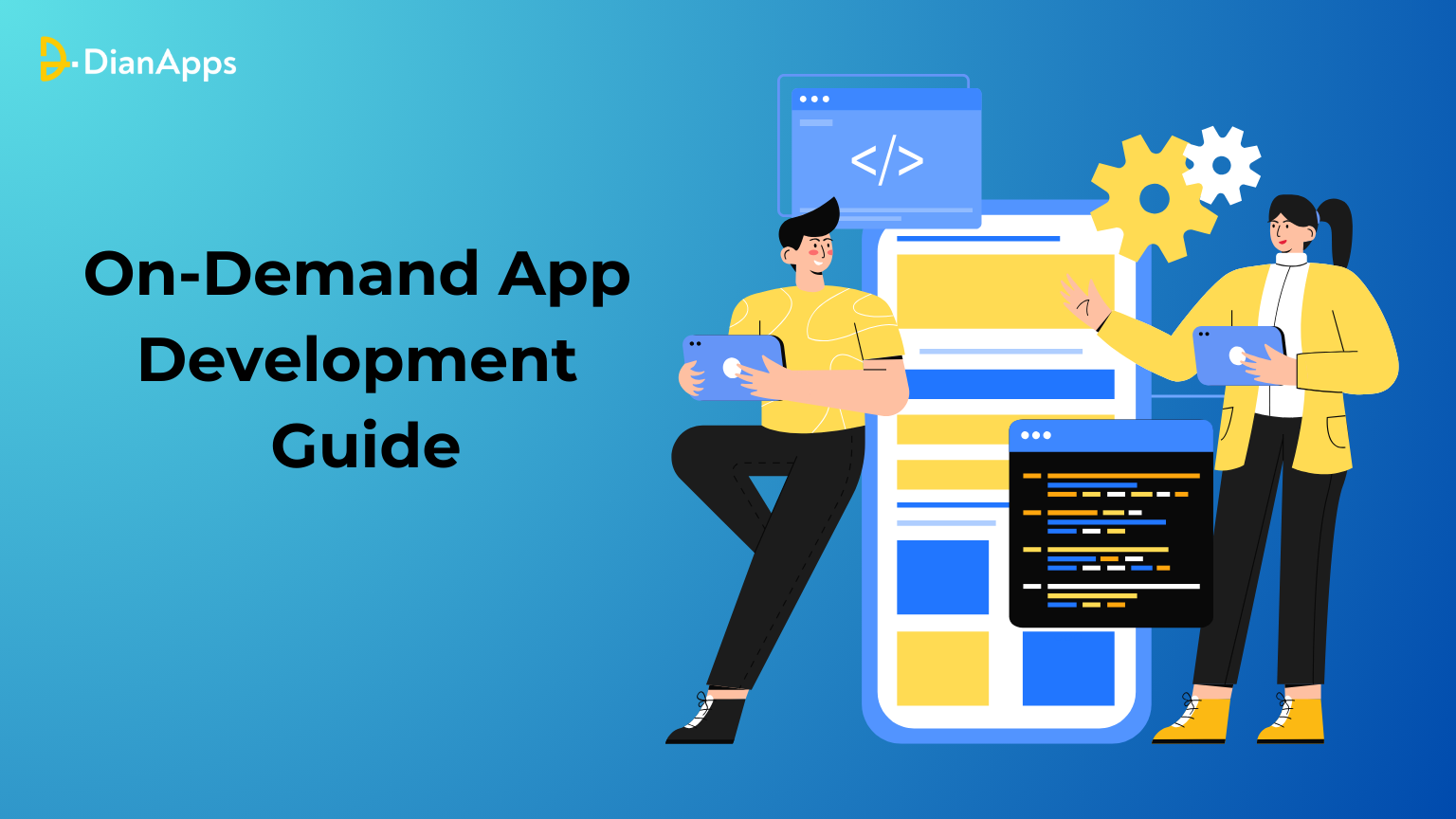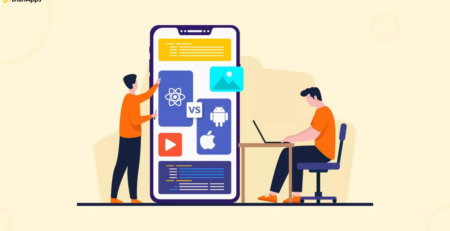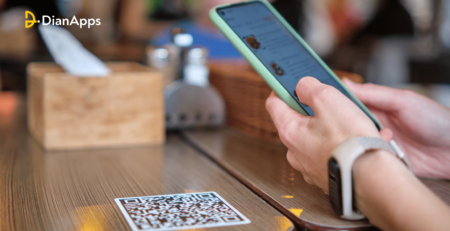On-Demand App Development Guide of 2023
The app industry has changed for good. With the constant need to provide modern solutions to customers, on-demand app development brings a complete package to organizations looking for eccentric game-changing quick fixes.
From home deliveries to car washing services, on-demand technology is going global to provide convenience to users and an opportunity for enterprises to grow their network across geographies.
Did you know?
“Applications for on-demand delivery are more in demand globally despite all the commotion in the app development industry. By the end of 2023, customers are predicted to spend more than $1 trillion on on-demand services, according to recent data.”
This escalation is backed by the increase in smartphone users and of course, the inception of on-demand apps such as Uber.
Want to know which other areas can on-demand app development services help your business in 2023? Well, there’s a lot to cover!
Let’s kick start by knowing the definition of on-demand alongside some useful kinds.
What is on-demand app development?
Users may rapidly buy things from a certain firm or schedule services using an on-demand application.
To save time and money, Uber, for instance, enables its users to schedule a trip at their convenience anytime anywhere.
Similar to this, meal delivery applications provide the greatest digital experience to your fingertips by comparing the best treats and pricing from many sources.
The development of technology has made it simple to address many common issues, allowing consumers to live better lives and fulfil their aspirations. This resulted in the growth of on-demand delivery apps as we have mentioned above.
However, some on-demand services, like Airbnb, don’t sell anything. They serve as the intermediary between the customer and the service provider, facilitating the connection of potential buyers and sellers on an online or app-based platform to meet their unique requirements. As a result, many on-demand applications fulfil a variety of functions, including advancing technology.
Types of On-Demand Applications
Business to Consumer (B2C)
B2C on-demand delivery apps make it easier for companies to provide goods or services to customers directly. This kind of application is used by particular eateries to support their customer service, such as Domino’s and Starbucks.
Business to Business (B2B)
Applications for B2B on-demand delivery are frequently used to supply services by putting companies in direct contact with one another for logistics or to carry out their operations. B2B on-demand applications are typically thought of as aids in the operations and logistics of other businesses.
Consumer to Consumer (C2C)
To sell or acquire things directly from another customer, C2C service providers and consumers employ P2P on-demand delivery applications. C2C on-demand delivery applications with a million daily users include Flipkart, Etsy, and Amazon, three delivery service providers.
Benefits Of On-Demand Apps:
More than 42% of Americans, according to the most recent poll, have used at least one on-demand app service, and this trend is not about to slow down. This is due to the widespread usage of on-demand services and the numerous advantages that these applications provide, such as,
- Broader base of customers
- Affordable prices
- Recognizing consumer trends and demand patterns
- Increasing client loyalty
- Removing the need for infrastructure
- Reducing reliance on manual labour
Best On Demand App Development Ideas For 2023:
The expectations of customers are always increasing as new technologies are introduced. As a result, on-demand delivery services are much more than just benefiting food delivery app for your business.
These applications are establishing new benchmarks for improved consumer experiences.
Here are a few eye candies that have been particularly selected from our database of app development experts for business owners hoping to upend the industry with their upcoming invention.
On-Demand Healthcare Delivery App:
Since the pandemic outbreak, on-demand software development for healthcare delivery has been steadily increasing and shows no signs of slowing down.
One of the most popular and profitable industries for developing on-demand applications is healthcare, as users of all ages utilize them quickly.
Doctors and patients may communicate anytime, anywhere, thanks to these applications in the healthcare industry. The programs have a large user base and allow users to quickly and easily obtain medical assistance from their cell phones during an emergency.
On-demand healthcare app development provides features like:
- Telemedicine
- Scheduling appointments Fitness
- EHM (Executive Health Management)
- Telehealth
- Services for tracking your diet.
Popular healthcare applications leveraging on-demand services:
- ZocDoc
- GoodRx
- Doctor On Demand
- Oberit
Also, Read the Ultimate guide to app development for healthcare in 2023!
On-Demand App for Domestic Use:
Another creative concept for on-demand app services is the ability to find trustworthy household necessities with a single click. On-demand applications for household requirements give a one-stop solution to all of these issues.
People used to struggle to obtain quick and reliable home services including cleaning, plumbing, electrical, and home maintenance.
An expert mobile app development company can assist in developing a revolutionary application with a strong technological stack that enables customers to locate all the home services they require on one platform.
The user chooses the service they desire from the list of possibilities, which includes options for home cleaning, plumbing, electrical, handyman, and other services, and may then book the service by including availability, location, and service pricing.
As an example, Uber Company aka UrbanClap, one of the biggest on-demand home service companies, links clients with experts who assist them in house cleaning or salon at home as per their daily demands.
Other on-demand applications for housework.
- HouseJoy
- Zimmber
- Mr.Right
- Family Handyman
- Timesaverz
- TaskRabbit
On-Demand Courier Delivery App:
Real-time connections between clients and delivery service providers are made via on-demand delivery applications for courier and postal services.
These applications have gained popularity in recent years by providing a quick and easy way for users to send and receive items. The development of on-demand courier delivery applications follows a concept where the consumer may enter a delivery request with a precise pickup and delivery location in the app.
The app then connects the request with a local courier driver who is available and pick up and deliver the delivery.
Increasingly popular apps for courier delivery
- Caviar
- Postmates
- DoorDash
On-Demand App For Food And Drinks Delivery:
The food and beverage sector is one of the most well-liked and often utilized industries for on-demand delivery app development.
The application may produce considerable revenue as it responds to the expanding need for convenient and effective delivery services since it is developed with engaging UX/UI, simple navigation, and on-the-spot delivery.
This industry has a lot of room for upheaval. These applications provide users with a seamless experience, from on-demand delivery apps for groceries and everyday requirements to on-demand delivery apps for prepared meals.
The dominant on-demand apps in this ecosystem.
- Uber Eats
- Grubhub
- Instamart
On-Demand Travel App:
On-demand travel apps are quite well-liked since they enable users to plan vacations to Miami while residing in a region of Asia.
An on-demand travel application that enables users to instantly book a variety of travel services, such as flights, hotels, car rentals, and excursions, has as its USP simplifying travel and cutting expenses.
Users demand hassle-free leisure travel, and on-delivery applications offer a quick and practical method to schedule travel plans, thus these apps present tremendous economic potential.
Popular travel applications are available on demand.
- Trivago
- Booking.com
- MakeMyTrip
MVP Features For Development Of On-Demand Apps:
MVP development is usually a wonderful idea before starting a real development process. Your application’s MVP is the version that has the bare minimum of functionality needed to confirm that there is a real demand for the service.
Making an MVP is essential for on-demand software and releasing it with a minimal set of functionality attracts early users and gauges market demand.
Customer App Features
- Login Page
Customers may register on the page by entering their email address or mobile number, or they can just log in using their social network or Google accounts.
- User Profile
All previous actions, including purchases, payments, cart contents, and reviews, are accessible through the user profile.
- Geolocation
Geolocation will make it easier to discover directions or deliver goods and food. Users may use location tracking to follow the ETA of their meal or merchandise.
- Placing orders and making payments
They have a variety of payment methods available to them, including cash, mobile wallets, debit cards, and credit cards.
- Notifications
Users can receive notifications about the service, the fee, the type of service, etc. via email and SMS services.
- Help and support
To get answers to their questions about the good or service, users can utilize the help and support option.
- Feedback
Users can provide their opinions about the program and its services.
Service Provider App Features
- Profile of a service provider
Similar to the user’s profile, the service provider logs into the app using the email address, social network account, or cellphone number.
- GPS assistance
The service provider can employ GPS assistance to provide the service or product precisely.
- Start and end of the delivery
Here, you can see all the details of the customer’s service request, including the beginning and finish of the service.
- In-app calls and messaging
Based on the information the consumer has supplied, the service provider will be able to get in touch with the customer during the service course.
- My earnings page
The supplier of the service should be able to monitor their revenue and the services they take.
On-Demand App Development In 5 Easy Steps?
Step 1: Research market trends, target audience needs, and competitors
Understanding the market trends, target market wants, and how rivals are addressing them is essential before designing the on-demand delivery app. So begin by conducting a thorough market analysis and look for areas for disruption. A rudimentary awareness of technological concepts offers an advantage and streamlines the development process while investigating trends and the industry. the ability to:
- If the app will be released on iOS, Android, the web, or all of these platforms?
- What will the application’s main features be?
- What technologies will be applied to the application’s support?
Step 2: Make an overall budget and find app developers
Choose a business strategy after determining the core service, then start strategizing about the features and total budget for developing on-demand delivery apps. The ability to avoid experimenting with multiple MVPs and to finalize the initial set of features to be added to the mobile app development process is made possible by having the prior budget.
Step 3: Hire a reputable on-demand app development company.
Your mobile app development concept might benefit greatly from working with a reputable on-demand app development company. They can even ask you for advice along the way on the features your users would want to see in the application’s beta version.
Hiring a reputable app development company that offers varying levels of continuous assistance, from creation to after-launch maintenance, is the next step in creating a successful on-demand app.
A high-end mobile app development partner will collaborate with customers and provide them with ideas on how to create an app with cutting-edge features and capabilities at the lowest possible cost.
Step 4: Talk about the project specifications and start the development
The most important step in the development of an app is discussing the project requirements with the on-demand app development firm. The tech team offers features and functionality for the application depending on the client’s requirements as part of the two-way requirement collecting process. The MVP of on-demand software typically includes elements like:
- Creating an account and logging into your app should be possible for users.
- Products and services should be available for users to choose from when placing an order.
- Customers ought to have the option of utilizing a secure payment gateway to pay for their orders.
- Users should be able to follow the status of their orders, including the projected time of delivery and the delivery driver’s present position.
- Customers have the convenience of giving feedback on the goods or services they’ve received.
Step 5: Create the app and release it.
The app is ready to begin development after the UX/UI design services and the foundational set of functionality have been chosen.
Depending on their needs, the development team will assist customers in selecting the target platform. The two primary mobile app development platforms are iOS and Android.
Once everything has been put together, the on-demand delivery app is prepared to accept customers.
Cost of developing an on-demand app
The complexity of the app, the number of features included, and the choice of development platform (iOS, Android, or both) can all have a significant impact on the cost of developing an on-demand app.
There isn’t a set pricing for it, but on average, it can cost anything between $30,000 and $150,000 to build an on-demand delivery software.
Therefore, it will be simpler for any app development service or an independent developer/freelancer to provide a pricing quotation the more explicit you are about what you want.
To help you comprehend the cost more fully, we have further divided it:
- Cost of documentation in total: between $1,000 and $2,000 (40 hours)
- Designing UI and UX: $1500 to $3000 (60 hours)
- Frontend/backend development costs range from $6000 to $20,000 (400 hours).
- $2,000 to $4,000 (80 hours) for QA testing
The sum of all these numbers will equal anywhere between $15,000 and $45,000.
Which is the top on-demand app development company in 2023?
Are you having trouble deciding which app development team to hire? Look nowhere else! DianApps provides dependable and reasonably priced on-demand app development services to help companies run their operations. We have a group of skilled app developers who are knowledgeable in the IT industry and adept at what they do.
The business has years of expertise in producing excellent mobile applications on schedule and at a reasonable cost.
Therefore, as a business, if you want to present yourself in the best possible light, you must collaborate with a firm that is both reputable and knowledgeable.
We provide 24/7 assistance and maintenance for our customers. And consider every project ours while working dedicated to offering the best.
Reach out to our experts to learn more!




